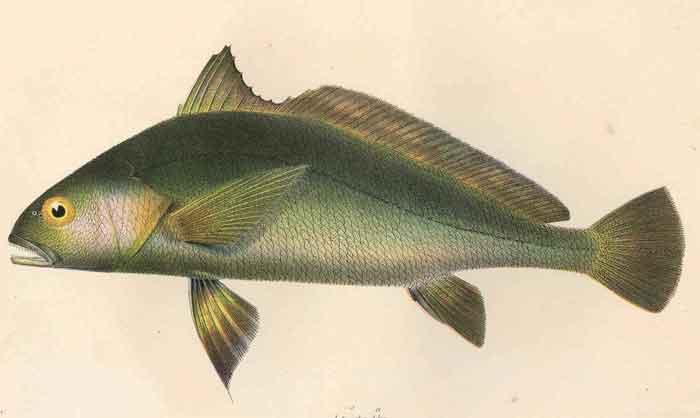Superregnum: Eukaryota
Cladus: Unikonta
Cladus: Opisthokonta
Cladus: Holozoa
Regnum: Animalia
Subregnum: Eumetazoa
Cladus: Bilateria
Cladus: Nephrozoa
Superphylum: Deuterostomia
Phylum: Chordata
Subphylum: Vertebrata
Infraphylum: Gnathostomata
Megaclassis: Osteichthyes
Superclassis/Classis: Actinopterygii
Classis/Subclassis: Actinopteri
Subclassis/Infraclassis: Neopterygii
Infraclassis: Teleostei
Megacohors: Osteoglossocephalai
Supercohors: Clupeocephala
Cohors: Euteleosteomorpha
Subcohors: Neoteleostei
Infracohors: Eurypterygia
Sectio: Ctenosquamata
Subsectio: Acanthomorphata
Divisio/Superordo: Acanthopterygii
Subdivisio: Percomorphaceae
Series: Eupercaria
Ordo: Perciformes
Subordo: Percoidei
Superfamilia: Percoidea
Familia: Sciaenidae
Genus: Pseudotolithus
Species: P. brachygnathus – P. elongatus – P. epipercus – P. moorii – P. senegalensis – P. senegalla – P. senegallus – P. typus
Name
Pseudotolithus Bleeker, 1863

Pseudotolithus epipercus
References
Pseudotolithus – Taxon details on Integrated Taxonomic Information System (ITIS).
Pseudotolithus species list in FishBase,
Froese, R. & Pauly, D. (eds.) 2024. FishBase. World Wide Web electronic publication, www.fishbase.org, version 02/2024.
Vernacular names
Pseudotolithus is a genus of marine ray-finned fish belonging to the family Sciaenidae, the drums or croakers. The species in this genus are found in the Eastern Atlantic Ocean.
Taxonomy
Pseudotolithus was first proposed as a genus in 1863 by the Dutch physician, herpetologist and ichthyologist Pieter Bleeker when he described the new species P. brachygnathus, P. epipercus and P. typus.[2] P. typus was designated as the type species by virtue of being named typus.[1] Ethelwynn Trewavas placed the eastern Atlantic Afrotropical sciaenids, Pseudotolithus and Pteroscion, in the tribe Pseudotolithini.[3] Other workers have placed this tribe in the subfamily Pseudotolithinae alongside the tribe Miracorvini, Miracorvina and Pentheroscion.[4] However, the 5th edition of Fishes of the World does not recognise tribes or subfamilies within the Sciaenidae which it places in the order Acanthuriformes.[5]
Etymology
Pseudotolithus prefixes Otolithus with pseudo meaning "false" due to Bleeker's perceived false resemblance between these fishes and those of that genus.[6]
Species
Pseudotolithus has the following valid species classified within it:[7]
Pseudotolithus brachygnathus Bleeker, 1863[8]
Pseudotolithus elongatus (Bowdich, 1825) (bobo croaker)
Pseudotolithus epipercus (Bleeker, 1863) (Guinea croaker)
Pseudotolithus moorii (Günther, 1865) (Cameroon croaker)
Pseudotolithus senegalensis (Valenciennes, 1833) (cassava croaker)
Pseudotolithus senegallus (Cuvier, 1830) (law croaker)
Pseudotolithus typus (Bleeker, 1863) (longneck croaker)
Characteristics
Pseudotolithus croakers have a carrot-shaped swim bladder running the whole length of the body cavity with a pair of long tube-like appendages growing out of its front. These appendages branch into as many as 32 tubules. They do not have any barbels on the chin.[3] The largest species in the genus is the law croaker (P. senegallus) which has a maximum published total length of 230 cm (91 in) while the smallest is the bobo croaker (P. elongatus) at 47 cm (19 in).[7]
Distribution
Pseudotolithus croakers are found in the Western Atlantic Ocean from Morocco in the north to Angola in the south.[8]
References
Eschmeyer, William N.; Fricke, Ron & van der Laan, Richard (eds.). "Genera in the family Sciaenidae". Catalog of Fishes. California Academy of Sciences. Retrieved 4 July 2023.
Bleeker, P. (1863). "Mémoire sur les poissons de la côte de Guinée". Natuurkundige Verhandelingen van de Hollandsche Maatschappij der Wetenschappen te Haarlem (Ser. 2) (in French). 18 (1862): 1–136.
A. R. Longhurst (1969). A synopsis of biological data on West African croakers (Pseudotolithus typus, P. senegalensis and P. elongatus) (PDF). Rome: Food and Agricultural Organization of the United Nations.
Kunio Sasaki (1989). "Phylogeny of the family Sciaenidae, with notes on its Zoogeography (Teleostei, Peciformes)" (PDF). Memoirs of the Faculty of Fishes Hokkaido University. 36 (1–2): 1–137.
J. S. Nelson; T. C. Grande; M. V. H. Wilson (2016). Fishes of the World (5th ed.). Wiley. pp. 497–502. ISBN 978-1-118-34233-6. Archived from the original on 2019-04-08. Retrieved 2023-07-05.
Christopher Scharpf & Kenneth J. Lazara, eds. (9 March 2023). "Series Eupercaria (Incertae sedis): Families Callanthidae, Centrogenyidae, Dinopercidae, Emmelichthyidae, Malacanthidae, Monodactylidae, Moronidae, Parascorpididae, Sciaenidae and Sillagidae". The ETYFish Project Fish Name Etymology Database. Christopher Scharpf and Kenneth J. Lazara. Retrieved 5 July 2023.
Froese, Rainer and Pauly, Daniel, eds. (2023). Species of Pseudotolithus in FishBase. February 2023 version.
Eschmeyer, William N.; Fricke, Ron & van der Laan, Richard (eds.). "Species in the genus Pseudotolithus". Catalog of Fishes. California Academy of Sciences. Retrieved 4 July 2023.
Retrieved from "http://en.wikipedia.org/"
All text is available under the terms of the GNU Free Documentation License

